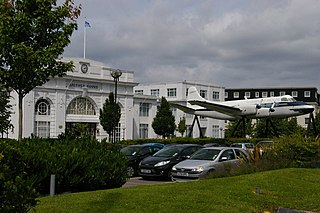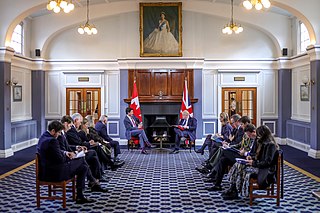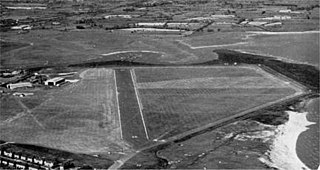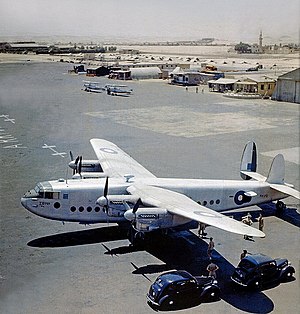
Croydon Airport was the UK's only international airport during the interwar period. It opened in 1920, located in Croydon, then part of Surrey. Built in a Neoclassical style, it was developed as Britain's main airport, handling more cargo, mail, and passengers than any other UK airport at the time. Innovations at the site included the world's first air traffic control and the first airport terminal. During World War II the airport was named RAF Croydon as its role changed to that of a fighter airfield during the Battle of Britain; and in 1943 RAF Transport Command was founded at the site, which used the airport to transport thousands of troops into and out of Europe.
Egyptair is the state-owned flag carrier of Egypt. The airline is headquartered at Cairo International Airport, its main hub, operating scheduled passenger and freight services to 81 destinations in Africa, Europe, Asia, and The Americas. Egyptair is a member of Star Alliance.

The Egyptian Air Force (EAF) (Arabic: القوات الجوية المصرية, romanized: El Qūwāt El Gawīyä El Maṣrīya), is the aviation branch of the Egyptian Armed Forces that is responsible for all airborne defence missions and operates all military aircraft, including those used in support of the Egyptian Army, Egyptian Navy and the Egyptian Air Defense Forces. The latter was created as a separate command in the 1970s and it coordinates with the Air Force to integrate air and ground-based air defense operations. The EAF is headed by an air marshal (lieutenant general equivalent). Currently, the commander of the Egyptian Air Force is Air Marshal Mahmoud Fouad Abdel-Gawad. The force's motto is 'Higher and higher for the sake of glory' (Arabic: إلى العلا في سبيل المجد, I‘la’ al-'olà fī sabīl al-magd). It was known as the Royal Egyptian Air Force until 18 June 1953 following the declaration of the Republic of Egypt by Muhammad Naguib.

The de Havilland DH.82 Tiger Moth is a 1930s British biplane designed by Geoffrey de Havilland and built by the de Havilland Aircraft Company. It was operated by the Royal Air Force (RAF) and other operators as a primary trainer aircraft. In addition to the type's principal use for ab initio training, the Second World War had RAF Tiger Moths operating in other capacities, including maritime surveillance and defensive anti-invasion preparations; some aircraft were even outfitted to function as armed light bombers.
This is a list of aviation-related events from 1956.

The de Havilland DH.89 Dragon Rapide is a 1930s short-haul biplane airliner developed and produced by British aircraft company de Havilland. Capable of accommodating 6–8 passengers, it proved an economical and durable craft, despite its outdated plywood construction.

Royal Air Force Northolt or more simply RAF Northolt is a Royal Air Force station in South Ruislip, 2 nautical miles from Uxbridge in the London Borough of Hillingdon, western Greater London, England, approximately 6 mi (10 km) north of Heathrow Airport. As London VIP Airport, the station handles many private civil flights in addition to Air Force flights.

No. 70 or LXX Squadron RAF operates the Airbus A400M Atlas C.1 to provide strategic air transport worldwide and is based at RAF Brize Norton.

Islay Airport is located 4.5 nautical miles north-northwest of Port Ellen on the island of Islay in Argyll and Bute, off the west coast of Scotland. It is a small rural airport owned and maintained by Highlands and Islands Airports Limited. Today the airport is used for scheduled services to the Scottish mainland, and for air ambulances.

Exeter Airport, formerly Exeter International Airport, is an international airport located at Clyst Honiton in East Devon, close to the city of Exeter and within the county of Devon, South West England. Exeter has a CAA Public Use Aerodrome Licence that allows flights for the public transport of passengers or for flying instruction. The airport offers both scheduled and holiday charter flights within Europe.

Nottingham Airport, also known as Nottingham City Airport, is located in Tollerton, Nottinghamshire, England. It is situated 3 nautical miles south east of Nottingham City Centre, and signposted on the A52 at Trent Bridge and on the A606—this makes it one of the closest airports to a city centre in the UK. The aerodrome is equipped for private aviation, business aviation and flight instruction.

Haifa Airport, also known as Uri Michaeli Airport, is a small general aviation airport located in Haifa, an Israeli city. It is located to the east of the city, close to Kishon Port and Israel Shipyards and mainly serves civilian flights, with some military usage. Most passenger flights utilizing the airport are domestic operations to Eilat and Tel Aviv. The airport is named after Uri Michaeli, one of the pioneers of Jewish aviation and one of the founders of aviation in Israel. The airport has one short runway, 1,318 metres (4,324 ft) in length, and there are plans to extend it by 316 metres (1,037 ft).

Redhill Aerodrome is an operational general aviation aerodrome located 1.5 NM south-east of Redhill, Surrey, England, in green belt land.

Heston Aerodrome was an airfield located to the west of London, England, operational between 1929 and 1947. It was situated on the border of the Heston and Cranford areas of Hounslow, Middlesex. In September 1938, the British Prime Minister, Neville Chamberlain, flew from Heston to Germany three times in two weeks for talks with Adolf Hitler, and returned to Heston from the Munich Conference with the paper referred to in his later "Peace for our time" speech from 10 Downing Street.
Gravesend Airport, located 2.5 miles (4.0 km) south-east of Gravesend town centre, Kent and 7.0 miles (11.3 km) west of Rochester. It was operated from 1932 until 1956. It was initially a civil airfield, and became a Royal Air Force station known as RAF Gravesend during the Second World War, when it was under the control of RAF Fighter Command during the Battle of Britain. It was the first RAF station to operate the North American Mustang III. The airport returned to civilian use at the conclusion of the Second World War, although it remained under the ownership of the Air Ministry until its closure in 1956. It is notable that a decision had to be made in 1954, by the Air Ministry, as to whether this civil airport should be retained and substantially enlarged, or the extensions east of Thong Lane be released for residential development. Kent County Council had made it clear that the land west of Thong Lane, was identified as a Civil Airport. Additionally, Kent County Council also informed the Air Ministry, that it would neither support nor oppose enlargement, acknowledging, however, that it would as a result of any such enlargement, the site becoming designated as a fully operational international airport.
Federal Airport Authority of Nigeria (FAAN) is a service organization statutorily charged to manage all Commercial Airports in Nigeria and provide service to both passenger and cargo airlines. Generally, to create conditions for the development in the most economic and efficient manner of air transport and the services connected with it. The agency has its head office on the grounds of Nnamdi Azikiwe International Airport in Abuja, Federal Capital Territory.

Royal Air Force Pengam Moors, or more simply RAF Pengam Moors,, is a former Royal Air Force station and maintenance unit (MU), located on the Pengam Moors area of Tremorfa, situated 2 miles (3.2 km) south east of Cardiff city centre in Wales, from June 1938 to January 1946.

Hounslow Heath Aerodrome was a grass airfield, operational 1914–1920. It was in the London borough of Hounslow, and hosted the British Empire's first scheduled daily international commercial flights, in 1919. The site today includes the main remaining part of Hounslow Heath.
Gatwick Airport was in Surrey until 1974, when it became part of West Sussex as a result of a county boundary change. The original, pre-World War II airport was built on the site of a manor in the parish of Charlwood. The land was first used as an aerodrome in the 1920s, and in 1933 commercial flights there were approved by the Air Ministry.

Bekesbourne Aerodrome was an airport located at the southeast edge of the village of Bekesbourne, southeast of Canterbury, Kent. It operated from 1916 until 1940, and had both military and civil roles.

















